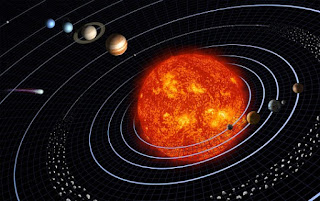Evolution of Universe
Origin of Universe
There are three main theories put forward to explain origin and evolution of universe.
1.BIG BANG THEORY
Most widely accepted theory regarding the origin of universe
Ans : Big Bang Theory
Big Bang Theory was proposed by
Ans : George Lemaitre
Big Bang Theory was modified by
Ans : Edwin Hubble
The term big bang was coined by
Ans : Fred Hoyle
Big bang theory is also called as
Ans : Expanding Universe Hypothesis
2. STEADY STATE THEORY
Steady State Theory was proposed by
Ans : Hermann Bondi, Thomas Gold and Fred Hoyle
Steady State Theory was proposed in
Ans : 1948
Quasi Steady State Theory was proposed by
Ans : Jayant Narlikar
3.THE PULSATING THEORY
The Pulsating Theory was proposed by
Ans : Dr. Allan Sandage
The theory which proposed that at present universe is expanding
Ans : Pulsating Theory
GALAXIES
A galaxy is a vast collection of billions of stars, dust, gas and empty space held together by
Ans : Gravitational force
The word galaxy was first introduced by
Ans : William Herschel
First person to calculate distance between galaxies
Ans : Sir Edwin Hubble
There are about 5Q billion galaxies exist in the universe
Group of galaxies is known as
Ans : Cluster
The most distant object visible to naked eye in the universe
Ans : Andromeda Galaxy
Our sun and its planets belongs to the
Ans : Milky Way Galaxy or Akash Ganga
First astronomer to demonstrate the existence of galaxies beyond milky way
Ans : Edwin Hubble (1924)
TYPES OF GALAXIES
1.Spiral Galaxies
2.Elliptical Galaxies
3.Irregular Galaxies
The galaxy having central nucleus with great spiral arms
Ans : Spiral Galaxy
Milky way and Andromeda are the examples of
Ans : Spiral Galaxies
New stars are formed in Spiral Galaxies Largest spiral galaxy
Ans : Andromeda Galaxy
The farthest object which can be seen with naked eyes
Ans : Andromeda Galaxy
The milky way belongs to a cluster of galaxies called
Ans : Local group
The galaxies having no spiral arms are called
Ans : Elliptical,Galaxies
Red Giants and white dwarfs are seen in the
Ans : Elliptical Galaxies
Dim collection of old stars are seen in the
Ans : Elliptical Galaxies
Galaxies having no regular shape
Ans : Irregular Galaxies
Large Magellanic cloud is an
Ans : Irregular Galaxy


















